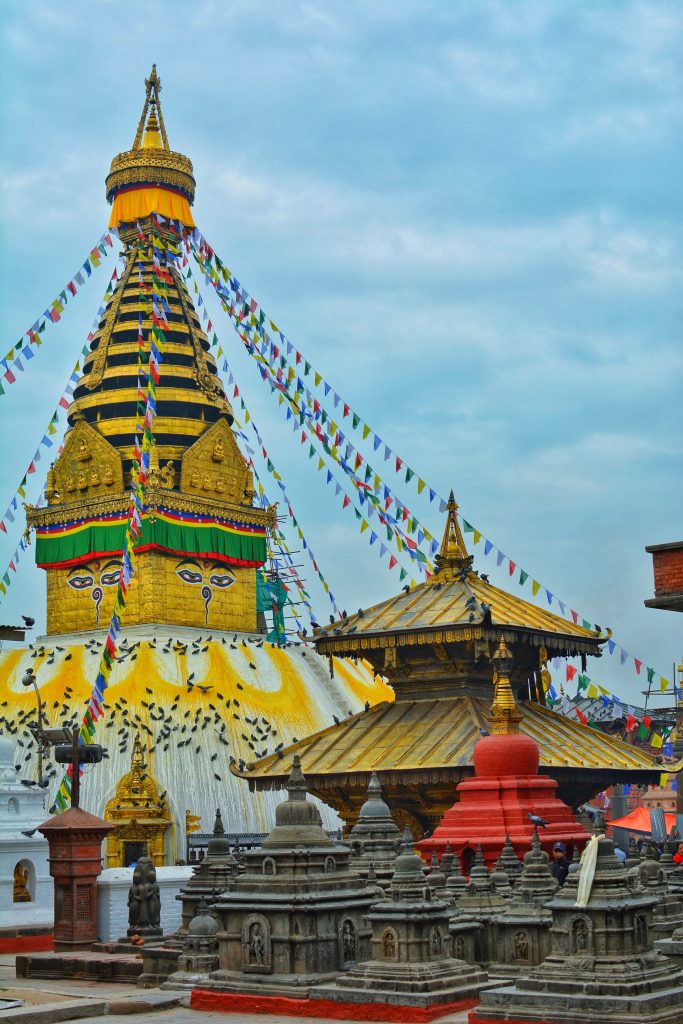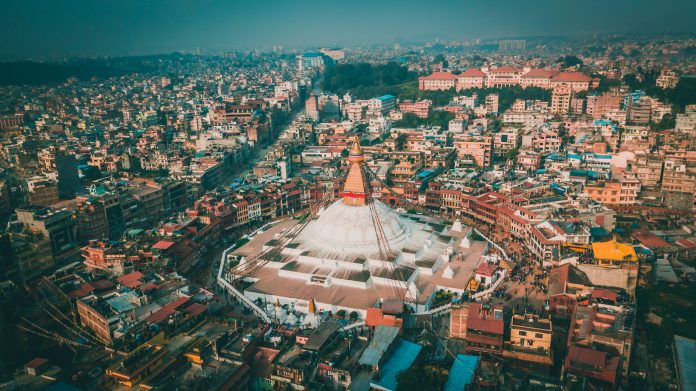Located in a valley surrounded by the Himalayan mountains, Kathmandu, Nepal’s capital city, is the perfect destination for anyone looking for rich culture, great food, and affordable prices.
Since I was five, I’ve spent my summers soaking in all that Kathmandu has to offer. I’ve explored every famous attraction, hidden gem, and food/drink spot that should be on every visitor’s radar.
1. Top Attractions
1. Swayambunath Stupa

The Swayambunath Stupa (just Swayambu to locals) is an ancient religious complex located on a hill in the Kathmandu valley. It consists of a stupa (a Buddhist monument that usually houses relics), numerous shrines and temples and a monastery. Swayambu was built in the fifth century and, although it’s technically Buddhist, it’s important to Hindus and Buddhists alike.
Every day, priests, pilgrims, worshippers, and tourists make their way up the 365 steps that lead to the top of the hill. There’s no entry fee, but many pilgrims and worshippers pay to light a butter lamp and pray for their deceased loved ones. At night, when all the people have left, hundreds of monkeys swarm Swayambu, giving it the unofficial name of ‘Monkey Temple’.
While the site doesn’t have set operating hours, people usually visit between six in the morning and ten at night. Generally, no one is allowed in after ten at night unless they are having a religious ritual.
2. Patan Durbar Square
Patan Durbar Square is one of three durbar squares in the Kathmandu valley and a UNESCO World Heritage Site. Considered a masterpiece of Newar architecture, its attractions include the palace of the Malla dynasty (who ruled Kathmandu Valley from 1201-1779) and several important temples.
The palace is gorgeous and consists of three main courtyards: Keshav Narayan Chowk (located inside the Patan Museum), Mul Chowk (the largest and most famous courtyard), and Sundari Chowk (where you can find stalls selling delicious Nepali food). The most well-known temple in the square is the Krishna Mandir, which is flooded with thousands of pilgrims during the annual Hindu festival of Krishna Janmashtami.
Patan Durbar Square is open every day from ten in the morning to ten at night. Nepalis don’t have to pay to enter but other nationalities have to pay varying fees.
3. Kathmandu Durbar Square
Kathmandu Durbar Square, like its Patan counterpart, is a UNESCO World Heritage Site. It houses the palaces of the Malla and Shah kings, the latter of which ruled until 2008, and several temples. Some buildings were unfortunately damaged during the 2015 earthquake, but many, if not most, remain intact and are worth visiting.
Nasal Chowk, probably the most well-known courtyard, was once where the Shah kings held important ceremonies, such as coronations, and today, many cultural rituals and performances are held in it. Mohan Chowk, where the Malla kings once hosted heads of foreign states, signed treaties, and made diplomacy, is characterized by its gorgeous medieval art. Trisul Chowk is known for housing the temple of Taleju Bhawani (the Malla kings’ favourite goddess), which, in my opinion, is a masterpiece of architecture.
Kathmandu Durbar Square is open every day from nine in the morning to five at night and its entry fee varies depending on the visitor’s nationality.
4. Boudha Stupa
The Boudha Stupa is a UNESCO World Heritage Site and is located on the traditional trade route from Tibet to the Kathmandu valley. It’s one of the largest stupas in Nepal and is said to house the remains of an ancient Buddha. Over fifty gompas (Tibetan centres of learning) surround it due to the influx of Tibetan refugees in Kathmandu.
Tibetan prayer flags are strung from the top of the stupa and on windy days, they look like a series of fluttering, multi-coloured waves. Eyes are painted on the base of the top of the stupa, meant to represent the all-knowing nature of the Buddha, and the stupa’s decorations are made of solid gold.
The Boudha Stupa is open twenty-four hours a day, seven days a week.
5. Thamel
Thamel is Kathmandu’s nightlife district. Buzzing with Nepali and international restaurants, bars with live music and various street vendors and shops, it’s been the centre of the city’s tourist industry since visiting hippies and artists popularised it. It’s not uncommon to see a rogue mountaineer wandering around Thamel’s narrow alleyways either, as the district serves as a pre-base camp.
It’s difficult to point to one shop or one restaurant to check out in Thamel, simply because there’s so much to do. I recommend just walking around for a few hours and popping into whatever strikes your fancy. One place I will tell you to go to, however, is Mandala Street, a pedestrian-only lane lined with Instagrammeable eateries and cute shops.
Thamel is always busy, whether it be ten in the morning or eleven at night, so there’s never a wrong time to visit. It’s fun to walk around with a group, so if you can, bring your friends or family along with you.
2. Hidden Gems
Siddhartha Art Gallery
Located in Baber Mahal Revisited, a complex of boutiques and restaurants in the style of a twentieth-century royal palace, Siddhartha Art Gallery hosts exhibitions of contemporary Nepali art and workshops, lectures and other events with local artists. With its relaxing atmosphere and elegant vibes, it’s the perfect place to escape the hustle and bustle of the city. Plus, Baber Mahal has tons of trendy restaurants and (albeit slightly overpriced) shops, so there’s tons of other stuff to do just a few feet away.
3. Getting Around
Luckily for tourists, taxis in Kathmandu are widespread, affordable, and convenient. It’s a bit like New York City, where you have to stand at the edge of the sidewalk and wave your arms for a taxi driver to notice you, but once you get the hang of doing that, it’s smooth sailing.
4. Food and Drink
1. Fire and Ice Pizzeria
Fire and Ice is the perfect place for dinner with friends, family, or even a significant other. It has an amazing ambience and a menu that’s a seventy/thirty mix of typical Italian restaurant fare and Nepali staples. My personal favourites are the Margherita pizza (it’s made with Nepali cheese!) and the chicken momos (Nepali dumplings).
2. Dechenling Garden Restaurant
If it’s not already clear by the name, Dechenling Garden Restaurant has a gorgeous garden, so make sure to ask for outdoor seating. I personally recommend the Tibetan-style momos, but pretty much everything on Dechenling’s menu is great. It serves mostly Tibetan food but the menu also has some Nepali and Indian dishes. Plus, there are great vegetarian options, so don’t worry if you don’t eat meat.
3. Alice
With its large indoor play area and kid-friendly menu, Alice is probably the best restaurant in all of Kathmandu to take the kids to. It has great food, great drinks, and reasonable prices. The indoor seating is spread across two floors, with each having its own unique vibe. Because of Alice’s popularity, however, the play area can get crowded and chaotic at times, so make sure you keep a constant eye on the little ones.
Words by Avantika Singh
Love Lifestyle? Read more here.
Support The Indiependent
We’re trying to raise £200 a month to help cover our operational costs. This includes our ‘Writer of the Month’ awards, where we recognise the amazing work produced by our contributor team. If you’ve enjoyed reading our site, we’d really appreciate it if you could donate to The Indiependent. Whether you can give £1 or £10, you’d be making a huge difference to our small team.
